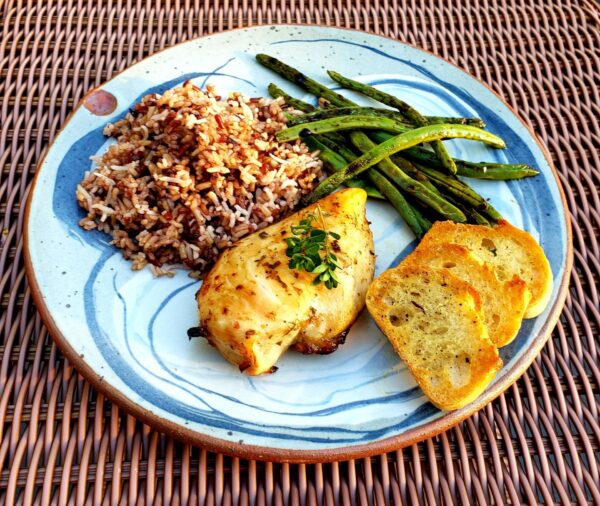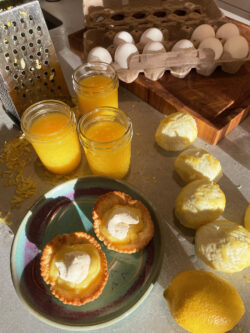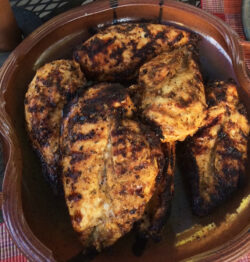So Many Ways to Cook

After almost 40 years, we recently remodeled our kitchen. For three months, we cooked without a regular oven, cooktop or, for all that time, running water. Having good camping cooking skills really helped, and we used our barbeque on the deck a lot. But the appliances that really helped us make it through those messy, noisy, and dirty months were a portable induction burner, a microwave, and a toaster oven. This proved to me that there are so many ways to cook!
During this “reality TV show” of an experience, we learned a lot about what recipes are good for what appliances, and about how to modify recipes to adapt to the appliance you are using. When deciding which appliance to use for which recipe, it helps to remember the positives and negatives of each kind of appliance.
Microwaves work by agitating molecules of water, sugar, and fat in your food. They basically work by “steaming” your food. Try zapping a piece of dry bread and you’ll quickly see how much water is really in it because it will be soggy. The disadvantages of microwave ovens are that you must avoid using dishes and utensils that include metal, they are usually limited by size, and they can change the texture of food. I always think reheated meat is rubbery in the microwave, but pasta or rice reheat well.
One of the best things we did was to use an induction burner during the remodel. We had a gas cooktop in the old kitchen but decided to replace it with an induction cooktop during the remodel. (It turns out natural gas stoves can give off some unhealthy gases like nitrogen dioxide and benzene, a known carcinogen.) I was afraid we would miss the rapid response of our gas cooktop, but the portable induction burner exceeded our expectations.
I used a portable induction burner when I taught patient cooking classes at Northwest Kidney Centers because it’s a fire-safe way to demonstrate cooking techniques. I knew they were reasonably priced, ($60-$200; check Consumer Reports for their reviews of best buys). But I had forgotten how responsive they were. They actually boiled water for pasta faster than our old gas range.
With a range of heat levels from 1–10, I was able to make everything from lemon curd to deep-fried salmon sticks, all with the same burner. And, the induction burner has such nice, very low temperatures, I decided I could give away my double boiler for melting chocolate and tempering eggs.
Induction cooktops do require that you have pans that have some iron in them. So sadly, a few of my favorite pans got moved to the “camping pots” box in the garage. But my cast iron frying pan, enamel Dutch oven, and several other pots worked just fine. A good test is to try a magnet on the bottom of your pan. If it sticks, chances are it will work on an induction burner.
The induction burner did take some getting used to. I started writing notes on my long-used recipes with the heat level that worked best. Some estimates tell me I am saving quite a bit of energy using the induction burner since it transfers about 90 percent of energy to the food. It is more efficient and both cooks and cools faster.
An entire range can be pricey, so check out whether a whole cooktop is what you need, or if a single burner will do. Since the remodel, we have taken the single burner camping when we have access to electricity, and to potlucks, where it has performed much better than our old option (a butane stove).
Toaster ovens are a third relatively new way of cooking. They can substitute for a regular oven in many cases but do best when you are cooking for a small group of one to three people. Benefits include heating up faster than your standard oven. It’s easy to check on how food is cooking through their large windows, and on a hot summer day, you won’t heat up your whole kitchen for one meal. You can save up to 50 percent of the energy of a regular oven.
Toaster ovens now come with all sorts of bells and whistles. Not only can you reheat leftovers while keeping foods crisper than a microwave, some toaster ovens include air frying, steaming, and convection options. You can raise bread in some with a low-temperature “proofing” option, while some toaster ovens allow you to slow cook stews and soups. Others even have a dehydrating option.
The main disadvantage for us was the size. These new multi-function ovens are a lot bigger, taking up a good amount of counter space, which was in short supply during the remodel. Many only have one rack, so you can only really cook one item at a time. In this case you will still need your microwave or an induction burner or your regular cooktop or oven.
Be a careful shopper with all these options. Prices can range from $30 for a basic toaster model up to $400–$500 for models with multiple cooking options. If you don’t cook for a lot of folks, or bending over to reach an oven is hard for you, and it’s time to replace your standard oven, you might consider this option.
To get you started on your “New Cooking Appliance Journey,” I’ve included some recipes below, almost all using lemon in some way, since it’s citrus season and the sweet sour of lemon is always a good way to cut down on salt, which isn’t healthy for people. Try the lemon curd on toast, pancakes, croissants, or angel food cake. The chicken and broccoli dinner will brighten up a dark winter’s eve. I modified these recipes from the Northwest Kidney Centers website, for use with induction burners, microwaves, and toaster ovens. But, as with all things related to cooking, the best bet is for you to venture into this new realm of cooking differently and figure out what works best for you. That’s often the joy of cooking—there is no one size fits all. It’s a boutique and you get to choose.
Lemon Curd with Induction Modifications
 2/3 cup lemon juice (about 4 lemons)
2/3 cup lemon juice (about 4 lemons)
2 cups granulated sugar
zest from 4 lemons
1 cup unsalted butter, frozen if possible
4 whole eggs, plus 1 yolk, well beaten
- On induction burner set at level 6, in saucepan, heat sugar, lemon juice and zest until sugar is dissolved, stirring regularly.
- Reduce heat to level 3, add butter. Let melt.
- Whip eggs with wire whisk in bowl. Slowly dribble about ½ cup of lemon butter mixture into beaten eggs, then slowly dribble egg mixture into saucepan with lemon butter mixture, whisking in.
- Raise heat level to 5–6. Stir regularly, about 5 minutes. Mixture should thicken and begin to “trace,” (leave drops or a line of curd on the surface when dripped off your spoon), or when it coats the spoon thickly. Remove when mixture thickens, or when it reaches 170 degrees. Don’t heat higher than 175 degrees, it may cook the egg too much.
- Pour through a fine strainer, to remove the zest and any small pieces of egg white.
- Keeps about one month in the refrigerator, or about one year if frozen.
Nutrition Facts, based on 2 tablespoon serving: Calories: 115, Carbohydrates: 14 gms, Protein: 1 gm, Sodium: 54 gms.
Microwave Lemon Curd
1 cup granulated sugar
3 eggs
2/3 cup fresh lemon juice
3 lemons, zested
1/2 cup butter, melted
- In a microwave-safe bowl, whisk together the sugar and eggs until smooth.
- Stir in the lemon juice, lemon zest and butter.
- Cook in the microwave for one-minute intervals, stirring after each minute until the mixture is thick enough to coat the back of a metal spoon.
- Remove from the microwave and pour into small sterile jars.
- Store for a month in refrigerator, or up to a year in the freezer.
Nutrition facts, based on 2 tablespoon serving size: Calories: 115, Carbohydrates, 14 gms, Protein: 1 gm, Sodium: 54 gms
Toaster Oven Chicken

1/2 cup lemon juice
3 tablespoons Dijon mustard
2 tablespoons honey
1 tablespoon fresh rosemary, minced
2 chicken breasts or 4 chicken thighs or mixture of both
- In a large bowl or big zip lock bag, mix together lemon juice, mustard, honey, and minced rosemary.
- Add poultry and turn to evenly coat.
- Cover or close tightly, and chill at least 30 minutes or up to a day; stirring or turning occasionally.
- Drain poultry and discard the marinade.
- Put the toaster oven on bake or grill, depending on the model.
- Cook about 20–30 minutes, until juices run clear, or thermometer reaches 165 at thickest part of chicken.
- Garnish with fresh rosemary sprigs.
Nutrition Facts, based on two servings of about 3 ounces each: Calories: 245, Carbohydrates, 9 gms, Protein 24 grms. Sodium: 280 mg
Toaster Oven Lemon Broccoli or Asparagus
1 pound fresh broccoli florets or asparagus spears, trimmed
3 tablespoons fresh lemon juice
1 tablespoon extra-virgin olive oil
1 teaspoon lemon peel, finely grated
- Preheat the oven to 450 degrees, or if that isn’t an option on your oven, to the highest temperature.
- Put broccoli or asparagus in a single layer on a baking sheet.
- Shake lemon juice, oil and lemon peel in a jar.
- Pour over vegetables, turning to coat.
- Roast until crisp-tender, turning occasionally, for about 10 minutes.
- Serve warm or at room temperature. Use leftovers in a salad the next day.
Nutrition Facts: based on 4 servings/recipe Calories: 59, Carbohydrates; 6 gm, Protein: 2 gm, Sodium, 2mg. Fiber: 3 gm
 Contributor Katy Wilkens recently retired as registered dietitian and department head at Northwest Kidney Centers. The National Kidney Foundation Council on Renal Nutrition has honored her with its highest awards for excellence in education and for significant contributions in renal nutrition. She has also been awarded the Medal of Excellence in kidney nutrition from the American Association of Kidney Patients.
Contributor Katy Wilkens recently retired as registered dietitian and department head at Northwest Kidney Centers. The National Kidney Foundation Council on Renal Nutrition has honored her with its highest awards for excellence in education and for significant contributions in renal nutrition. She has also been awarded the Medal of Excellence in kidney nutrition from the American Association of Kidney Patients.
Photos by Rich Wilkens.
Eating Well, Living Well classes
Studies show that working with a registered dietitian can delay kidney failure and postpone dialysis for longer than two years. FREE nutrition classes taught by Katy’s former team of registered dietitians are available at convenient times and locations around Puget Sound.
Eating Well, Living Well classes teach people how to eat healthier to slow the progress of kidney disease and postpone dialysis. Learn more at www.nwkidney.org/classes.
![AgeWise King County [logo]](https://www.agewisekingcounty.org/wp-content/themes/agewisekingcounty/images/logo.png)